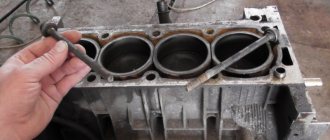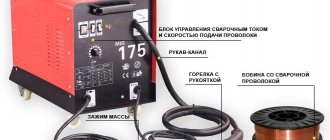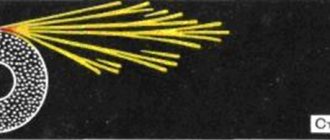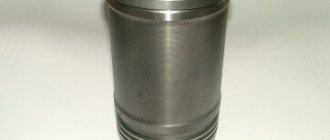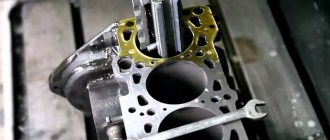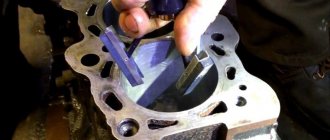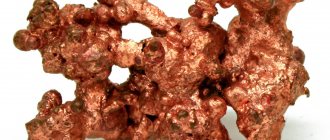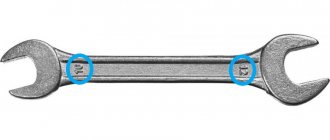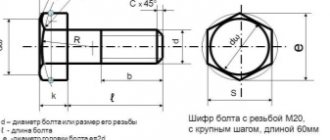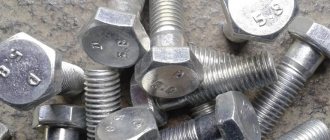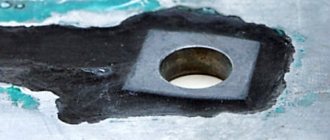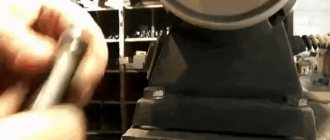In the process of repairing and servicing a car, as well as any other equipment, there is often an urgent need to remove individual elements of the internal combustion engine or chassis, body panels, etc. At the same time, removing engine components, attachments and suspension is often the most problematic operation. The reason is that the units can be tightened with bolts or studs, and the tightening torque is quite large.
If we add to this temperature changes in the engine compartment, oiling, accumulation of dust, dirt and other deposits, it becomes clear that unscrewing various bolts and other fasteners is not only a responsible and time-consuming, but also often a difficult task. In this article we will talk about what you can do if a stud or bolt breaks, as well as how to unscrew a broken bolt.
Effective ways to remove a broken bolt from an engine block
Not only will the bolts become loose, but they may also be over-tightened or mis-threaded. This may not have any effect on operation, but the next time you disassemble the connection, it will be difficult to unscrew the hardware. You have to put in a lot of effort. Because of this, the following consequences arise:
- the thread breaks;
- fasteners crack;
- the hat breaks off.
For one or more reasons, the fastener cannot be unscrewed from the seat in the usual way.
If we are talking about the cylinder head, then a large tightening torque is used here, which is why the above consequences arise. Before unscrewing a broken bolt, you need to perform preparatory measures:
Clean the hardware itself and the area around it from accumulated oil, rust, and dirt using a wire brush and solvent. The joint should then be further treated with a penetrating compound such as WD-40, brake fluid or clean engine oil. Thanks to this procedure, the bolts should loosen.
If the bolt breaks above the threaded surface
This case is considered easy, because the protruding pin means that the bolt has been unscrewed at least a little, and this also allows the use of clamping tools, as well as other manipulations to unscrew the fragment with a screwdriver or using a rod.
- To break up the rust and tear off the hardware, it is recommended to first tap the fastener with a hammer through the extension and heat it with an induction bolt heater or a blowtorch. The rotating pin is unscrewed using pliers, an adjustable wrench or another similar tool. When tapping, do not use much force, because you can break the threads in the hole or damage other parts.
- Using a hacksaw or grinder, slots are also cut into the fragment for a flat or Phillips screwdriver, and then unscrew it.
- If the fragment protrudes above the surface to a sufficient height, then a through transverse hole can be drilled in the body, into which a thick long nail, a metal rod or even a screwdriver is then inserted. The protruding parts of the tool at hand will not only allow you to influence the rest of the bolt, but will also play the role of a lever.
Method 3 - welding on the nut or head
Of course, not everyone is good at welding, but you can ask a friend. The essence of the method is to weld a nut onto the problem bolt and then unscrew it.
But, in most cases, this nut also breaks off, so many experts recommend welding a head instead, preferably an already broken one, so that it won’t be so bad.
The advantages of this method:
- The head is higher and you can insert a key with a large lever into it;
- It is more convenient to scald, the scalding area will be larger, which means the head will hold tighter.
The ideal option is to use a semi-automatic device; for a conventional inverter, a 2 mm electrode is used.
After welding, wait until the metal cools down. Then insert a wrench with a large lever into the head and begin to unscrew the bolt.
What to do first
Before proceeding to the main actions, you can carry out preliminary “operations” - this will increase the chances of successfully removing the debris, and, perhaps, will help get rid of it immediately.
First of all, you can try to knock on the fragment, if possible, with a hammer. No need to hit hard. Such actions will loosen the bolt, making it easier to remove.
You can also try to warm up the part well in the place where the fragment remains. A gas burner is used for this. This will relieve internal tension. Remember: it is important to use the burner carefully if the part is made of aluminum - it can simply melt it.
You first need to warm up the part in the place where the fragment is located. This must be done extremely carefully
It wouldn't hurt to pour some W-40 type liquid into the hole. If not, you can use a dirt and rust remover. Such lubricating fluids will help facilitate the “exit” of the bolt fragment.
W-40
If during the preparatory process the fragment has not yet come out, it’s time to move on to a more radical method. Let's look at it in more detail below.
Let's sum it up
As you can see, there are several ways to unscrew a broken bolt or stud. Moreover, in each case, it is necessary to separately take into account in advance the nature of the broken body, the location of the fragment itself, the possibility of access to the problem area, the possible consequences of heating the remains of the bolt, etc.
The same can be said about tightening studs or bolts. The fact is that fasteners must be tightened with a strictly defined force and in the specified order (for example, covering the cylinder head). Ignoring this rule often leads to studs or bolts breaking, stretching, deforming, etc.
How to remove a broken bolt: step-by-step instructions
The most difficult thing to remove is a bolt fragment that has a non-flat surface - during the drilling process, the drill can simply slip, and the part will be damaged, and removing the bolt will become more difficult.
This is what a broken bolt looks like in detail
To make it easier, it is worth injecting the lubricant again, and then using a guide bushing that matches the thread. It must be screwed into the hole until it stops, and then tightened with a lock nut.
Matched bushing
Using a drill, you need to make a small hole in the fragment for the extractor. It is recommended to lubricate the end of the drill with lubricant.
Important! It is better to drill exactly in the center - this will make it easier to remove the fragment.
Making a hole with a lubricated drill
If everything is in order, you can continue drilling - you will not damage the thread, since the recess has already been created. You just can’t drill through the fragment - you can damage the part, especially if it is made of soft metal.
The next step is to drive a suitable size screw extractor into the hole. Make sure it is firmly secured and does not slip out. If this is the case, you can begin to carefully and slowly unscrew the extractor along with the fragment.
Screw extractor We turn out the fragment
The broken bolt has been removed, all that remains is to check whether the thread is intact - to do this, you need to screw a new bolt into the hole. To make this easier, you can lubricate the threads with lubricant.
The extracted bolt fragment. As you can see, his thread remained intact thanks to careful actions. The item is not damaged
In the process of removing the bolt, you will use chemicals, possibly heat the part in the hole, use impact tools and drill, so it is important to take care of personal protection: it is better to wear gloves, long sleeves, glasses, and, if possible, a respirator to protect the respiratory tract.
This method will help you remove a broken bolt even from a deep hole, if you do everything correctly and follow safety precautions. There are other methods, but we cannot vouch for their effectiveness, while the method described above always works flawlessly.
How to unscrew an internal hexagon with torn edges
To unscrew a bolted connection with a through hole, you can use a file. With its help, the hexagonal hardware is bored to the next size and unscrewed with a wrench.
The second way is to use Torx. They can punch out new splines and reuse the hex hardware, but subsequently it can only be unscrewed with a Torx sprocket.
Torx sprockets
In addition, before unscrewing the torn hexagon, you can saw through the internal axis of the hexagonal fastener for a screwdriver and unscrew it. With this method, it is not always convenient to get to the fastener; sometimes its location does not allow the use of a screwdriver.
Features and advantages of cylinder head studs
Almost every car is equipped with studs, and not serial bolts, to secure the cylinder head. The steel used for their manufacture can significantly increase the level of tightness of the engine head gasket. This ensures a reliable gasket seal and eliminates the possibility of oil and coolant leaks.
If used for a long time due to metal aging, this cylinder head part requires replacement. Possible damage when removing the head. The work is quite painstaking and requires a lot of effort.
All work must be carried out in stages and some recommendations must be followed.
The reason for the breakdown of the edges of screws and bolts
There are several reasons. They usually occur in three cases:
- When choosing hardware for fastening certain parts of a mechanism, device or structure.
- In case of violation of technology when working with fastening tools.
- When using low-quality, faulty tools during installation or dismantling.
The choice of fastening elements (screws, bolts, studs, nuts, etc.) must be done carefully. Purchase only high-quality products, taking into account the scope of application and the influence of external factors
It is important to pay attention to the certificates of products and manufacturers, since now there are many handicraft workshops in gateways that produce hardware from ordinary wire and low-quality rods
As a result, the service life is short, the most vulnerable places of bolts and screws become corroded, and due to a violation of the technological process, the strength of the metal in critical areas of the product decreases (the transition from the body to the head, splines and edges on the head). When purchasing such fasteners, there is obviously a risk of damage to the hardware by the tool during operation.
When installing or dismantling any structure, you must use a serviceable tool to screw in and unscrew screws, screws and bolts. Make sure that screwdrivers and keys do not have “licked” or chipped working surfaces. Do not allow screwdrivers to slip through the edges of the head or keys around the bolt head.
Also, the causes of failure may be: “sticking” due to exposure to high temperatures, wear due to prolonged mechanical loads, corrosion due to long-term operation under aggressive environmental influences, use of the wrong tool for unscrewing, etc.
Replacing the stud
It is better to carry out planned replacement of studs and repair of the head at the same time. For a simple replacement, before unscrewing it, it should be moistened with brake fluid or a brake fluid. It should be unscrewed using a special stud puller or a gas wrench. Unscrewing, especially at the beginning, should be done smoothly, without jerking.
If the force is not enough, you can use an extension cord. It is important to feel the effort here and not miss the moment when the pin begins to twist and break. At the first sign, it is better to reapply brake fluid and let it sit. Move on to the next detail. The pin is unscrewed, move on to the next one. After unscrewing all the studs, we return to the soured part.
We are trying to unscrew it. It may work out, but often such a part breaks off. If it works, install the head with the gasket in place and begin tightening the nuts according to the diagram, observing the tightening torque:
- First, we tighten each nut, going in a circle with a special wrench with a dynamometer;
- Then we go through it several times after a short break to seal the gasket;
- We do the final tightening of the nuts. The cylinder head tightening torque is different for different engine models; it is better to find out this value from the repair manual.
Common Mistakes
Despite the fact that automakers clearly indicate the procedure and nuances of tightening the cylinder head, many car enthusiasts make mistakes when assembling the engine. The most common of them are:
- Pouring oil into the mounting holes to lubricate the threads (the liquid is incompressible, so poured oil will not allow the head to be properly tightened);
- Over-tightening (exceeding tightening forces leads to damage to the cylinder head and the fasteners themselves);
- The use of damaged or inappropriate keys (the edges of the bolt heads may be torn off, after which it will be problematic to tighten or unscrew them normally);
- Use of unsuitable bolts as replacements (fasteners from different engines may differ in length, thread spacing, head height and diameter);
POPULAR WITH READERS: Cylinder misfires, causes, diagnostics, repair
To avoid problems in the future, you should use only fasteners designed for a specific engine and fully comply with the work conditions.
How to unscrew the threads remaining in the block?
There are two options here, but each of them begins with drilling out the fragment. To do this, you should cover the engine block with a thick cloth to prevent sparks and dirt from entering the engine, then cut off the top part with a grinder and place it strictly in the middle.
Drilling out the threads of a broken stud
Using a drill of a slightly smaller diameter, we drill out the fragments on a drilling machine, or most often with an electric drill. Here it is very important to hold the instrument strictly vertically, without distortion. We reach the edge of the trim and try to unscrew the rest of the thread. To do this, before unscrewing, you can try to drive it with a tap or try to hammer the edge of the metal inward with a thin chisel, freeing the threads.
If you fail when unscrewing or drilling, you need to move on to the second option.
Method 2 - drilling and unscrewing with a chisel
Suitable for cylinder head bolts with outer edges that have been torn off.
- Using a drill and a 10 mm drill bit, drill a hole in the center of the bolt, the depth of which should extend beyond the height of the edges of the head.
- Place the chisel at a right angle and, with strong blows, punch an edge in the bolt 2-3 mm deep.
- Place the chisel at a 45-degree angle to the surface of the head and begin to unscrew it with strong counterclockwise blows. Usually you have to beat for 4 to 5 minutes for the process to start.
Extractors
An extractor is a special device that allows you to remove the remains of faulty fasteners or unscrew a broken pin. The device is very simple and at the same time ingenious. In order to remove a stuck or broken part, you need to somehow hook it and then unscrew it. And all this is done very simply. You need to drill a hole in the center of the stud, wedge some tool in the shape of a cone or cylinder into it, then use this tool to remove the bolt. This is the extractor. These devices make it much easier to resolve issues such as unscrewing a broken pin from a manifold or from any other places.
There are several types of extractors:
Now these devices can be purchased in sets, but they are also available for sale individually. Experts recommend using these tools. They make solving difficult situations such as broken bolts much easier.
